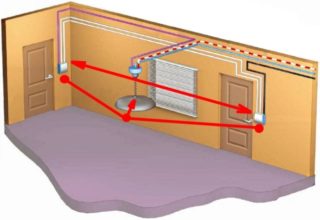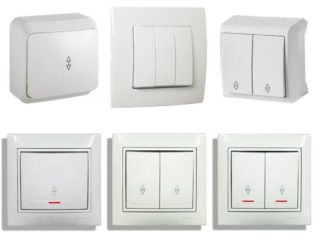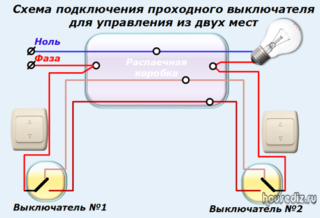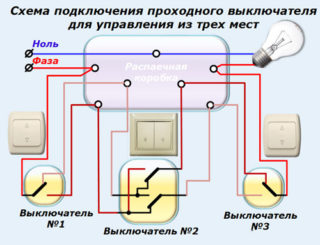The single-key pass-through switch is a special type of household switching devices, the need for which arises in special cases. Their installation is advisable in walk-through rooms, in which it is necessary to turn on the lighting from the side of the entrance, and turn it off when leaving. For this, the switch kit includes two electrically interconnected devices that are installed in appropriate places.
Application examples

The capabilities of such switches allow you to avoid many of the inconveniences that you have to face in everyday life. An example of application is a case when a user needs to cross a long corridor, and it is desirable to do this not in the dark, but in full light. When exiting, a second key device is used, through which the light can be extinguished. Moreover, the direction of movement on such an object does not matter.
The system is built in such a way that after passing through the corridor, the switch is ready for a new actuation, but already at the entrance from the other side.
Other places where a twin changeover device is often installed are the entrance to the bedroom and the area around the bed. In this situation, it will be possible to enter the lighted room, and then turn off the light, getting ready for bed.
Features and principle of operation
Such switches should be installed only in pairs, which ensures the sequence of switching the lighting line from two points remote at considerable distances.
The similarity with conventional devices is limited by the fact that they are also included in the phase wire break.
The principle of operation of the pass-through switch is based on switching the same line by alternately supplying voltage to the light bulb from both sides at once. This possibility is realized due to a special switching circuit, according to which two wires are connected to the lighting device (each of them is alternately supplied with a voltage of 220 volts).
When wiring such circuits, the cores are distinguished by the marking of the insulation, one of which is gray and the other is white.
For one of the two pass-through one-key switches to work, the key of the second must be in the on (up) position. Only in this case, the phase voltage supply circuit from the side of the second device will be closed, and the principle of operation of the light switches will be fulfilled.
Types of pass-through switches

According to the number of switching contacts, the following types of pass-through switches are distinguished:
- one-key;
- two-key;
- three-key.
The number of keys can mean a lot to the functionality of each of the listed devices, since they allow you to switch fixtures from three points in the room or more.
If it is necessary to control from 3 or more places, the best option is a two-button device with cross control.
When comparing multi-button switches to their single-button counterparts, it is important to understand how one can differ from the other. The main difference concerns the functionality of the devices installed in the room. If in the second case only one group is switched (the illuminator is switched on and off), then there will be two such groups in the circuit with a two-key switch. In accordance with the scheme of their connection, you can turn on the first of the two illuminators, while turning off the second, or vice versa.
By their design, such switches can have an open (outdoor) design or be installed in niches prepared in advance in the wall. According to the control method, the switch can be touch-sensitive or from the remote control, that is, it can be triggered by touch or remotely (remotely). The choice of a specific type of device is determined by the user's preferences, as well as his financial capabilities.
Three-point switching
It consists of two switches already discussed earlier, housed in a single one-piece housing. In it, a common key is installed on a conventional rocker mechanism, consisting of two parts, which makes it possible to switch lines outgoing from it synchronously. To get a triple two-key switch, you will need to modify a conventional crossover device by installing jumpers on it.
The multi-point connection scheme is organized in such a way that the "earth" wire is led in parallel to two lighting groups, and the phase (in red insulation) goes to each of the input terminals of the first switch. Regardless of the position of the keys, the voltage will flow only through the even input terminals (through the white and gray wires), and only after that, through the previously installed jumper, it enters the input of the second pass-through switch.
The direction of the phase potential supply to the lighting devices depends on the position of the keys. If one of the groups of fixtures is on, it is enough to turn off any of the fixtures to de-energize it. The same process occurs when you turn it on, only in this case, a change in the position of any key entails the restoration of the power circuit.
Choice of execution option
When choosing a suitable type of single-button pass-through switch, the following points are taken into account:
- first of all, you will need to decide on the brand of the purchased device, which is selected based on personal preferences;
- the number of toggle keys is selected, which depends on the required number of points from which the illuminators should be controlled;
- the installation method of the purchased device is determined (open or closed).
The walk-through key switch, in accordance with its functional purpose, allows you to control the fixtures from two or three remote points, making it easier to handle them.










